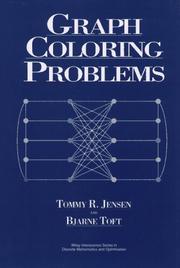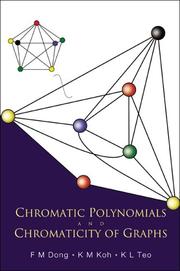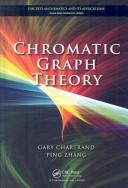| Listing 1 - 10 of 13 | << page >> |
Sort by
|

ISBN: 0471028657 9780471028659 Year: 1995 Publisher: New York, NY : John Wiley,
Abstract | Keywords | Export | Availability | Bookmark
 Loading...
Loading...Choose an application
- Reference Manager
- EndNote
- RefWorks (Direct export to RefWorks)
Map-coloring problem. --- Graph coloring --- Graph coloring.
Book
ISBN: 354060717X 3540493018 9783540607175 Year: 1996 Volume: 1623 Publisher: Berlin Springer
Abstract | Keywords | Export | Availability | Bookmark
 Loading...
Loading...Choose an application
- Reference Manager
- EndNote
- RefWorks (Direct export to RefWorks)
Discrete mathematics --- Graph coloring. --- Graphes, Théorie des
Book
ISBN: 1316234185 1316236072 1139519794 Year: 2015 Publisher: Cambridge : Cambridge University Press,
Abstract | Keywords | Export | Availability | Bookmark
 Loading...
Loading...Choose an application
- Reference Manager
- EndNote
- RefWorks (Direct export to RefWorks)
Chromatic graph theory is a thriving area that uses various ideas of 'colouring' (of vertices, edges, and so on) to explore aspects of graph theory. It has links with other areas of mathematics, including topology, algebra and geometry, and is increasingly used in such areas as computer networks, where colouring algorithms form an important feature. While other books cover portions of the material, no other title has such a wide scope as this one, in which acknowledged international experts in the field provide a broad survey of the subject. All fifteen chapters have been carefully edited, with uniform notation and terminology applied throughout. Bjarne Toft (Odense, Denmark), widely recognized for his substantial contributions to the area, acted as academic consultant. The book serves as a valuable reference for researchers and graduate students in graph theory and combinatorics and as a useful introduction to the topic for mathematicians in related fields.
Book
Year: 2023 Publisher: New York,NY,United States Association for Computing Machinery
Abstract | Keywords | Export | Availability | Bookmark
 Loading...
Loading...Choose an application
- Reference Manager
- EndNote
- RefWorks (Direct export to RefWorks)
Computer science. --- Graph coloring --- E-learning --- Computer vision
Book
ISBN: 1000007166 3866441800 Year: 2007 Publisher: KIT Scientific Publishing
Abstract | Keywords | Export | Availability | Bookmark
 Loading...
Loading...Choose an application
- Reference Manager
- EndNote
- RefWorks (Direct export to RefWorks)
This book investigates register allocation for programs in static single-assignment form.Its main result is that the interference graphs of SSA-form programs are chordal.This gives the compiler precise knowledge over the register demand and allows for separating spilling, assignment and coalescing. For each of these phases, we present methods specially tailored to the SSA setting and provide a first evaluation.
Compiler
---
Register Allocation
---
Graph Coloring
---
Graphfärbung
---
Registerzuteilung
---
SSA Form
---
Codegeneration
---
Codegenerierung
---
Übersetzerbau
---
Register

ISBN: 1281881090 9786611881092 9812569464 9789812569462 9781281881090 9789812563835 9812563830 9789812563170 9812563172 9812563172 9812563830 Year: 2005 Publisher: Singapore World Scientific Pub.
Abstract | Keywords | Export | Availability | Bookmark
 Loading...
Loading...Choose an application
- Reference Manager
- EndNote
- RefWorks (Direct export to RefWorks)
This is the first book to comprehensively cover chromatic polynomialsof graphs. It includes most of the known results and unsolved problemsin the area of chromatic polynomials. Dividing the book into threemain parts, the authors take readers from the rudiments of chromaticpolynomials to more complex topics: the chromatic equivalence classesof graphs and the zeros and inequalities of chromatic polynomials.
Graph coloring. --- Graph theory. --- Polynomials. --- Algebra --- Graph theory --- Graphs, Theory of --- Theory of graphs --- Combinatorial analysis --- Topology --- Coloring of graphs --- Extremal problems

ISBN: 9781584888000 1584888008 9780429138560 Year: 1977 Publisher: Cleveland CRC Press
Abstract | Keywords | Export | Availability | Bookmark
 Loading...
Loading...Choose an application
- Reference Manager
- EndNote
- RefWorks (Direct export to RefWorks)
519.1 --- 519.1 Combinatorics. Graph theory --- Combinatorics. Graph theory --- Graph coloring --- Coloriage de graphes --- Graph coloring. --- Graph theory --- Graphs, Theory of --- Theory of graphs --- Combinatorial analysis --- Topology --- Coloring of graphs --- Extremal problems --- Graph theory. --- Théorie des graphes --- Graphes, Théorie des --- Topologie combinatoire --- Probleme du coloriage
Book
ISBN: 0821838253 Year: 2006 Publisher: Providence, R.I. American Mathematical Society
Abstract | Keywords | Export | Availability | Bookmark
 Loading...
Loading...Choose an application
- Reference Manager
- EndNote
- RefWorks (Direct export to RefWorks)
Discrete mathematics --- 51 <082.1> --- Mathematics--Series --- Graph coloring --- Ramsey theory --- Random graphs. --- Coloriage de graphes --- Ramsey, Théorie de --- Graphes aléatoires --- Random graphs --- Coloring of graphs --- Graph theory --- Graphs, Random --- Combinatorial analysis --- Coloriage de graphes. --- Ramsey, Théorie de. --- Graphes aléatoires.
Book
ISBN: 9783319203942 3319203932 9783319203935 3319203940 Year: 2015 Publisher: Cham : Springer International Publishing : Imprint: Springer,
Abstract | Keywords | Export | Availability | Bookmark
 Loading...
Loading...Choose an application
- Reference Manager
- EndNote
- RefWorks (Direct export to RefWorks)
A comprehensive treatment of color-induced graph colorings is presented in this book, emphasizing vertex colorings induced by edge colorings. The coloring concepts described in this book depend not only on the property required of the initial edge coloring and the kind of objects serving as colors, but also on the property demanded of the vertex coloring produced. For each edge coloring introduced, background for the concept is provided, followed by a presentation of results and open questions dealing with this topic. While the edge colorings discussed can be either proper or unrestricted, the resulting vertex colorings are either proper colorings or rainbow colorings. This gives rise to a discussion of irregular colorings, strong colorings, modular colorings, edge-graceful colorings, twin edge colorings and binomial colorings. Since many of the concepts described in this book are relatively recent, the audience for this book is primarily mathematicians interested in learning some new areas of graph colorings as well as researchers and graduate students in the mathematics community, especially the graph theory community.
Mathematics. --- Graph Theory. --- Combinatorics. --- Mathématiques --- ;. --- Algebra --- Mathematics --- Physical Sciences & Mathematics --- Graph coloring. --- Coloring of graphs --- Graph theory. --- Graph theory --- Combinatorics --- Mathematical analysis --- Graphs, Theory of --- Theory of graphs --- Combinatorial analysis --- Topology --- Extremal problems
Book
ISBN: 0817680918 9786612973673 1282973673 0817680926 Year: 2011 Publisher: New York : Springer,
Abstract | Keywords | Export | Availability | Bookmark
 Loading...
Loading...Choose an application
- Reference Manager
- EndNote
- RefWorks (Direct export to RefWorks)
Ramsey theory is a relatively “new,” approximately 100 year-old direction of fascinating mathematical thought that touches on many classic fields of mathematics such as combinatorics, number theory, geometry, ergodic theory, topology, combinatorial geometry, set theory, and measure theory. Ramsey theory possesses its own unifying ideas, and some of its results are among the most beautiful theorems of mathematics. The underlying theme of Ramsey theory can be formulated as: any finite coloring of a large enough system contains a monochromatic subsystem of higher degree of organization than the system itself, or as T.S. Motzkin famously put it, absolute disorder is impossible. Ramsey Theory: Yesterday, Today, and Tomorrow explores the theory’s history, recent developments, and some promising future directions through invited surveys written by prominent researchers in the field. The first three surveys provide historical background on the subject; the last three address Euclidean Ramsey theory and related coloring problems. In addition, open problems posed throughout the volume and in the concluding open problem chapter will appeal to graduate students and mathematicians alike. Contributors: J. Burkert, A. Dudek, R.L. Graham, A. Gyárfás, P.D. Johnson, Jr., S.P. Radziszowski, V. Rödl, J.H. Spencer, A. Soifer, E. Tressler.
Graph coloring. --- Graph theory. --- Mathematics. --- Ramsey numbers. --- Ramsey theory -- History. --- Ramsey theory. --- Ramsey theory --- Ramsey numbers --- Graph theory --- Graph coloring --- Mathematics --- Physical Sciences & Mathematics --- Algebra --- History --- Dynamics. --- Ergodic theory. --- Convex geometry. --- Discrete geometry. --- Combinatorics. --- Dynamical Systems and Ergodic Theory. --- Convex and Discrete Geometry. --- Combinatorial analysis --- Differentiable dynamical systems. --- Discrete groups. --- Groups, Discrete --- Infinite groups --- Differential dynamical systems --- Dynamical systems, Differentiable --- Dynamics, Differentiable --- Differential equations --- Global analysis (Mathematics) --- Topological dynamics --- Combinatorics --- Mathematical analysis --- Discrete mathematics --- Convex geometry . --- Geometry --- Combinatorial geometry --- Ergodic transformations --- Continuous groups --- Mathematical physics --- Measure theory --- Transformations (Mathematics) --- Dynamical systems --- Kinetics --- Mechanics, Analytic --- Force and energy --- Mechanics --- Physics --- Statics
| Listing 1 - 10 of 13 | << page >> |
Sort by
|

 Search
Search Feedback
Feedback About UniCat
About UniCat  Help
Help News
News